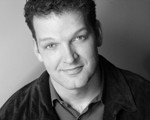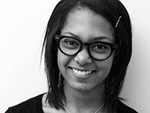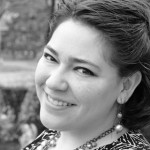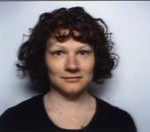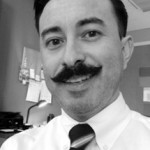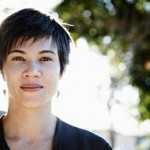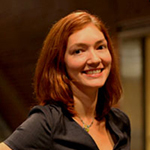April 2014 Blog Salon
April 2014 Blog Salon
With a Little Help from My Friends – A Verbose Thank You to Emerging Arts Leaders
April 2014 Blog Salon
Reading between the Lines: Crossing the Generational Barriers of Ethnic and Cultural Audience Development
April 2014 Blog Salon
Charting the Future: Why we need new Visionary Ideas, Values, and Models to Propel Communities forward through the Arts

Ms. Jaclyn R. Johnson
Charting the Future: Investing in Nashville Artists
Posted by Apr 25, 2014

Ms. Jaclyn R. Johnson
My April calendar is filling up nicely with runway shows, play openings, art crawls, and artist workshops. This really shouldn’t surprise me. After all, Nashville has stepped into the spotlight in the last few years as one of the nation’s new “it” cities according to New York Times writer Kim Severson. GQ calls this burgeoning southern city “Nowville” noting that “it's the most electric spot in the South, thanks to a cast of transplanted designers, architects, chefs, and rock 'n' rollers.”
For many of our local arts leaders, the national attention brings opportunity and trepidation. Our city is awake and moving towards its future as the world watches. Severson describes the threat saying that “the ingredients for Nashville’s rise are as much economic as they are cultural and, critics worry, could be as fleeting as its fame.” Currently, artists innovate outside of traditional funding opportunities. Our first artist housing development fills immediately with no new opportunities in sight, work-space prices continue to climb pushing artists to the city’s edges, and divisions still exist between genres and organizations.
Read More
Abe Flores
Thanks for Joining our Emerging Leaders Blog Salon on the Future of the Arts
Posted by Apr 21, 2014

Abe Flores
The future of art administration is in good, capable, and innovative hands. This week’s Emerging Leaders Blog salon demonstrated a commitment to art as a public good, as a solution to a myriad of social problems, and as an intrinsic piece to the full development of the self and community. The blog salon also gave us a peak into the future, introduced us to new models for the arts, and a new visions for arts leaders & their development. Most importantly the blog salon introduced us to exciting leaders – new, young, emerging, experienced, mid-career, seasoned (marinated?), established, and/or just plain awesome.
Read More
Mr. Nicholas Dragga
So Let’s Actually Do Research and Development
Posted by Apr 18, 2014

Mr. Nicholas Dragga
Among other issues, I hear emerging leaders wanting a larger voice in their organization – a chance to use their knowledge and skills. From the “established leaders” in my area, I hear not knowing exactly how to use, or maybe engage, emerging leaders (ELs) and their ideas. Senior leaders are sometimes unsure or afraid of how to fit these new ideas into the organization’s structure or culture since there are reasons things are done they way they are, and sometimes (often) organizations are big ships to turn.Of course, finding a voice in your organization is a huge issue with lots of nuances, and this issue could certainly be articulated better or maybe even more correctly, but I think we all get that we all want a vibrant and relevant organization that is regenerative in its thinking and programing. There are systems in place that have grown and sustained the organizations to what they are today, and new ideas like [insert your brilliant idea here] in the pipeline that are exciting, engaging, and even revolutionary will keep organizations relevant. So, how do we bring out great ideas and engage leaders at all stages, all the while maybe even having some fun? Yes, this is a lofty goal. Further, is this lofty goal, or unicorn, possible without a huge culture shift or organizational overhaul?
Read More
Mr. Todd Eric Hawkins
Charting the Future: Why we need new Visionary Ideas, Values, and Models to Propel Communities forward through the Arts
Posted by Apr 18, 2014

Mr. Todd Eric Hawkins
When I think about the future, both my own personal future and that of the arts, my mind immediately recalls a quote by Wayne Gretzky. The quote came to me via Ben Cameron, Program Director for the Arts at the Doris Duke Charitable Foundation. During his keynote at the Emerging Arts Leaders Symposium at American University, Mr. Cameron recited the following:
“I skate to where the puck will be, not where it has been.” – Wayne Gretzky
As emerging leaders we have an opportunity to change the way current arts organizations operate, or create new ones while exploring new ideas, new values, and new models. We, as the next generation of arts leaders, will navigate through the largest generational shifts in decades. Who will our audiences be in twenty years and how will we serve them?
Read More
Jerome Socolof
“It’s a bunch of people in horns singing in languages I don’t understand for longer than I want to listen.”
Posted by Apr 18, 2014

Jerome Socolof
“It’s a bunch of people in horns singing in languages I don’t understand for longer than I want to listen.” Whose brilliant summation of opera is this? Why, that would be mine, circa 2003. It was, admittedly, an ill-informed viewpoint, one underpinned by the misperceptions of elitism and grandiosity in opera that many people hold, but I was only 17 at the time. After becoming a music major, and thanks largely to the tireless work of a few professors, I was soon sliding down the slippery slope to being in love with opera. After realizing that I lacked the voice and single-minded dedication to be a professional performer of opera, I knew that I had to be an administrator so that I could stay involved. 10 years, three college degrees, and a few shifts in the cultural landscape later, I still feel the same way.
Read More
Ms. Lindsay So
Branching Out – Nurturing Emerging Leaders to be Bigger than the Job
Posted by Apr 18, 2014

Ms. Lindsay So
There were times when I would mention that I was starting a new job with the City of Philadelphia and the most frequent response was a remark about the “Good Government Job”—somewhere I could stay for a long time with the implication that I could never be fired. Sure, this comment might have been a joke but even so, I hadn’t really thought of it that way. Sure, having health benefits for the first time would be a major plus for me, an arts manager early in my career, but what motivated me most was the opportunity to learn about and directly impact the arts and culture community of a major city. Citywide programs, grant making, creative development opportunities, policy changes—I pictured myself having a hand in making Philadelphia a city where artists could thrive and residents could enjoy a diverse range of arts and culture experiences. I now believe this difference in perspective is generational: my peers in City Hall share my ambition and passion to affect change and make an impact with our work.
Read More
Mr. George P. McLeer, Jr.
USE US
Posted by Apr 18, 2014

Mr. George P. McLeer, Jr.
As we sat down with our Congressmen this past March during National Arts Advocacy Day, one message kept coming out of my mouth, “In my community, we don't just 'fund' the arts, we use the arts.” I didn't arrive in Washington with that phrase in my mind. I didn't even think about it until after our “advocacy sessions,” the day before we visited Capitol Hill.
What alarms me the most about our annual trek to Capitol Hill is that our ask never seems to change— “We would like our Representative/Senator to support funding the NEA/Arts Education at this specific level.” We mention the ability to leverage the arts for economic impact, improve education, and make our lives more fulfilling, but at the end of the day we ask for money—either from the federal government or private citizens via tax policy shifts.
We need to stop asking for money and instead ask for a new vantage point.
Read More
Maria Fumai Dietrich
Inspiring College Student Engagement in the Arts
Posted by Apr 17, 2014

Maria Fumai Dietrich
As a university advisory to about 50 student performing and visual arts groups, I see firsthand the impact extra-curricular programs and elective coursework in the arts make on student's professional and personal development. The majority of the hundreds of students served through Platt Student Performing Arts House at The University of Pennsylvania will not pursue careers in the arts sector. However, it is this population of arts appreciators who will support local theater, participate in book clubs, donate to after school arts programs, and so forth after graduation. As a sector, we need to creatively engage the extra-curricular art lovers while they are young so as to ensure strong audiences in the future.
Institutions of higher education, arts and culture organizations, and all levels of government share the responsibility of engaging extra-curricular art lovers. Within the last year alone, Philadelphia has seen strong development in the quantity of organizations taking this responsibility seriously with quality programming. This recent uptick in engaging programming is a sign that organizations recognize the long-lasting value of building relationships between arts and culture communities and college students (regardless of whether or not their academic pursuits are arts-related).
Read More
Ms. Sarah M. Berry
The Controversy of ‘Artist as Philanthropist’: When giving art away is okay
Posted by Apr 17, 2014

Ms. Sarah M. Berry
Artwork IS work. That is the credo many artists inherit. Artists learn not to give away their art or services, and good art lovers should know not to ask. Yet all artists have been approached to donate to a charity auction or volunteer to photograph an event, usually with the promise of great exposure and a free meal. But even an emerging, hungry, do-gooder artist like me knows the “I give it away for free” brand of exposure can be a slippery slope. A few rounds of generosity could gain me the reputation as an “artist philanthropist” and the requests for handouts—and the fear of decreased artwork values—that follow.
Even among artists, there is an expectation that certain art should be free (or at least on certain nights of the week, for students, seniors, practicing artists, friends of arts administrators, or library card holders.) Free events often come under the auspices of increasing arts access, though unfortunately busy and broke people with limited access to art (and transportation) may not have “Free Nights” on their radar, may feel uncomfortable attending, or may not be able to get there. The arts aren’t happening where they are, so making art free may not change the equation.
Read More
Whitney Roux
Take the Lead: Musing of a Professional Development Junkie
Posted by Apr 16, 2014

Whitney Roux
Professional development takes many forms, from hands-on workshops to panel discussions. Important opportunities for leadership and building relationships with mentors provide a robust calendar of growth options. An Emerging Leader’s plan for success needs to explore how to best combine education tracks to improve at their current job while simultaneously growing into their dream career.
As a Steering Committee member of the Rising Arts Leaders of San Diego (RALSD), I work with my committee to develop programs that fit the needs of emerging leaders in arts and culture. We build workshops, facility tours, and discussions around issues that affect our arts community, meanwhile crossing departmental bridges with networking events and social gatherings. But personally, I have found that the best professional development happens when you get your hands dirty.
Read More
Molly Uline-Olmstead
Whole Educators: A New Model for Teacher Professional Development
Posted by Apr 16, 2014

Molly Uline-Olmstead
Museums go with schools like peanut butter goes with jelly. It is a beautiful symbiotic relationship built on a variety of interactions including field trips, distance learning, traveling artifact programs, and teacher professional development. While I have worked with all of these programs in the past, I have been living in the teacher professional development neighborhood of the museum world since 2009. I work with K-16 teachers and other museum educators on projects meant to support and enhance teaching in the humanities through my job with the Creative Learning Factory at the Ohio Historical Society (the Factory).
Lately in conversations with teachers and museum colleagues, we have been talking less about content and more about learning. We have been asking the question, “How do we make learning an inextricable part of life?” Educators in formal and informal learning environments are bombarded with resources, regulations, and tremendous responsibilities. We struggle to find balance and time for exploration and reflection amid testing, lesson planning, and classroom management. Peter D. John articulates this frustration well in his 2006 article about non-traditional lesson planning, "The model of planning and teaching represented in this minimalist conception develops as follows: aim > input > task > feedback > evaluation. It reflects an approach to teaching and learning wherein reflection and exploration are at worst luxuries, not to be afforded, and at best minor spin-offs, to be accommodated.” As cultural organizations, we are in that unique “third space,” which allows us to facilitate those crucial habits-of-mind that lead to life-long learning. I think of this as looking at the “whole educator” in the same way the education field has championed the “whole child.”
Read More
Ruben Quesada
A Rare Species in the Midwest
Posted by Apr 16, 2014

Ruben Quesada
"Man's capacity for justice makes democracy possible; but man's inclination to injustice makes democracy necessary." - Reinhold Niebuhr
In thinking about the impact of art on society, and in my case the impact of literature, I look back to the poetry of Walt Whitman, who in 1855 self-published Leaves of Grass. Whitman’s determination and willful inclusivity put him ahead of his time. Adapting to the changing pressures of the world around him, Whitman took the subject of the Civil War to render with convincing appeal the volatility of his nature and time. He resisted existing poetics conventions and used candid language to more accurately represent the world around him; he showed the beauty and ugliness of the men and women in America on equal terms. The subject of his poetry was of the ordinary—the working class, drug addicts, prostitutes, the rich and the poor. The tradition of Whitman’s “barbaric YAWP over the roofs of the world” continued to echo through most of the Twentieth century. It was subsequent generations of poets who sustained this idea (e.g., Paul Laurence Dunbar’s Lyrics of Lowly Life, Carl Sandburg’s Chicago, Allen Ginsberg’s Howl, Gwendolyn Brooks’ The Bean Eaters). Poetry for and about everyday Americans was born with Whitman and for most of the Twentieth century it became the standard. Readers like to see themselves in the stories they hear; they like the familiar. In many ways the stories found in literature help readers understand what is artful, beautiful, or good. As a poet the world around me informs the content of what I write. Often, as with any art, social and political movements influence its content and creation. Many social and political revolutions have been born through art because it has the power to make us question what is right and wrong. Take for instance the work of performance artists Karen Finley and Tim Miller, two of the NEA Four whose artwork led them to be denied an NEA grant because of the content of their artwork; the content of their work led lawmakers, artists, and art lovers to question what they considered to be art. Where do we draw the line between pornography and art? What is art?
Read More
Mr. Joshua Russell
The Rise of the Mid-Career Arts Professional
Posted by Apr 15, 2014

Mr. Joshua Russell
It sounds like a superhero sequel: First there were arts leaders, then came emerging leaders and now, the 'mid career arts professional' movement is gaining steam. I mean Americans for the Arts is creating a pre-conference for them at the upcoming Annual Conference in Nashville. It has to be legit, right?!
For most of my arts career, I saw myself and was viewed as an emerging leader. I took great pride in participating in meetings representing the future of the arts. But recently that has changed. I took notice of it when the folks at genARTS Silicon Valley (our region’s emerging leader network) started calling me “the Godfather” or was it “the Grandfather”? I’m pretty sure it was the first one, but either way, the message was clear - I wasn’t really one of them anymore.
Read More
Teresa Hichens Olson
The Cost of Creativity
Posted by Apr 15, 2014

Teresa Hichens Olson
My morning has been spent with 26 third graders mummifying Barbies, writing in hieroglyphics, and learning about ratios in relation to an ancient Egyptian cure for stomachaches. (The cure, by the way, is a mixture of garlic and honey, which produces enzymes in the body to reduce acid. A cool fact no matter how old you are.)
I start each class, as I always do, with four words: I am an artist. And my goal each day, no matter which classroom I’m in or age group I'm working with, is to show each student that they are artists as well--which may seem a bit idealistic or naïve, but after 22 years of teaching, I've found it always to be true, because the definition of art for me is wide.
My favorite type of student is the Hater. The one who says he or she hates art, followed by either a wonderful eye roll or guttural groan. It is this child who was taught early on that art is a flat thing which doesn’t break rules, that has to behave a certain way and is only good if the person standing in the front of the room says it’s good. We’ve all been in that class. And it isn’t the kind of art that builds bridges between creative thinking, innovation, and science. Art can be dangerous. And, I would argue, it needs to be.
Read More
Emiko Ono
Arts Leadership and the Changing Social Contract
Posted by Apr 15, 2014

Emiko Ono
Since I began working in the arts in 2001, there has been a subtle but constant pressure on the sector to transform that can be both distressing and motivating. I will never forget the time in 2003 when Mark O’Neill, then the Head of Museums and Galleries for the city of Glasgow (Scotland), described how a population of shipyard workers reported that they did not attend a nearby museum because the price of admission was too expensive. The nauseating twist was that the museum did not have an admission fee. Last week, this story came to mind again as I spoke with Susie Medak, managing director of Berkeley Repertory Theatre and an arts leader with more than 25 years of experience. Susie’s hypothesis—that the tacit social contract between society and arts organizations is changing—is one I have found to be incredibly useful. The premise of her theory is that it is no longer sufficient for arts organizations to provide distinctive work, attract an audience, and secure financial support—it needs to include wider swaths of people who are largely not involved.
Read More
Michelle Paul
Automated Asks and Personalized Packages: Arts Management in 2023
Posted by Apr 14, 2014

Michelle Paul
For the past nine years, I've been in the business of creating new technology systems for the arts, and teaching arts managers (particularly those in marketing, development, and box office roles) how to get the most value out of the tools available to them.
The world's technology landscape has changed dramatically in the nine years I've been at my job. Thanks to all the amazing developments that have happened since early 2005 (YouTube, iPhones, and Twitter ...just to name a few), today's arts patrons are more tech savvy, more connected, and more engaged than they were when I started working in this industry.
Many of today's arts managers are keenly aware of the opportunity that this presents, but there are some who look at these trends and sound alarm bells for the end of the arts world as we know it. With so many “high tech” entertainment options available, will people continue to value traditional art forms? If the very idea of "tweet seats" makes you shudder, it's easy enough to look at technological advancement as yet another challenge that's facing the arts.
Read More
Dr. Brea M. Heidelberg
With a Little Help from My Friends – A Verbose Thank You to Emerging Arts Leaders
Posted by Apr 14, 2014

Dr. Brea M. Heidelberg
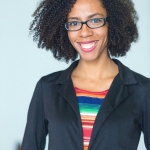
Elena Muslar
Reading between the Lines: Crossing the Generational Barriers of Ethnic and Cultural Audience Development
Posted by Apr 14, 2014

Elena Muslar
“We have got to diversify our audiences!” How many times can you recall hearing this phrase in meeting after meeting? And yes, of course, the mantra still rings true. But, what are the ways in which target marketing campaigns reach out to those diverse audiences?
“It’s Black History Month! Let’s offer a special on tickets to ‘A Raisin in the Sun’! The Latin show is coming to town; let’s advertise our banners along the streets of East LA.” I could go on, but now is not the time to dwell on past mechanisms of “outreach” done with fairly good intentions. This is the time to go beyond talking about these kinds of basic ideals of promotion and start changing our values towards active relations. It’s the time to chart the future and put models into play that not only shift, but flip, the paradigms set in place that don’t currently reflect expanding communities meant to be served by arts organizations.
As a young woman of mixed race, being half-Black/half-Belizean, I am a product of a community that was just “out of reach”; that desperately needed the “out-reaching”. When more criminals cross the threshold of your apartment complex than high school graduates, you learn early on that you have to be strong enough to stretch your reach further when that reach from the other side doesn't make it far enough. As a “Next Gen” arts leader, this has been a huge inspiration for me to have a voice that extends beyond my community and into those buildings laden with white walls. I see myself as a bridge between worlds and am committed to paving roads that provide better access to communities resembling mine.
Read More
Abe Flores
Charting the Future: Why we need new Visionary Ideas, Values, and Models to Propel Communities forward through the Arts
Posted by Apr 14, 2014

Abe Flores
Change is the only constant in life and in art. Demographic shifts, technological leaps, economic cycles, and cultural trends require creative, knowledgeable, and skilled leaders to ensure the relevance and resilience of all art forms. When old ideas, values, and models become obsolete, it takes leaders to chart the future to accommodate the changing reality. Experimentation, risk and failure are inherent in the charting of the future. No one knows if something will really work until they implement it. That is why I am a fan of the term “pilot program” - it tells the world that we are trying something new and it may not work. Younger leaders often take on the role of charting the future and piloting programs because we are the future: demographically diverse, technologically savvy, and more inclusive in our values.
The Americans for the Arts Emerging Leaders Council, a body of fifteen incredibly smart, visionary and engaged young arts professionals, acts as a brain trust informing and advising Americans for the Arts (AFTA) on trends, new ideas, latest models, and the direction of the field in order to assist in developing new programs and resources to promote professional development and networking opportunities for young professionals nationwide. Part of my role at AFTA is liaising with the council and working with them to present and implement their best ideas and strategies. In the couple of months I have been working with them it has become clear that there is much great work yet to be done. I am very excited to see what develops and very thankful to be part of the process. My brain is divided between my immediate daily tasks (blog salon, convention, digital classrooms etc.) and contemplating how we can best serve and advance the field.
Read More







